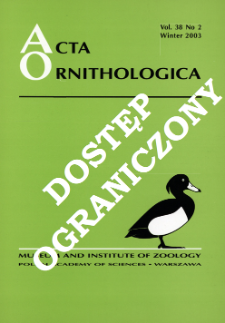- Search in all Repository
- Literature and maps
- Archeology
- Mills database
- Natural sciences
Advanced search
Advanced search
Advanced search
Advanced search
Advanced search

Object
Title: The breeding bird community of a primaeval temperate forest (Białowieża National Park, Poland) at the end of the 20th century
Creator:
Wesołowski, Tomasz (1950– ) ; Tomiałojć, Ludwik (1939– ) ; Mitrus, Cezary ; Rowiński, Patryk ; Czeszczewik, Dorota
Date issued/created:
Resource type:
Subtitle:
Acta Ornithologica, vol. 37, no. 1 ; Zgrupowanie ptaków lęgowych pierwotnego lasu Białowieskiego Parku Narodowego pod koniec XX wieku ; Bird community of a primeval forest
Contributor:
Polska Akademia Nauk. Muzeum i Instytut Zoologii.
Publisher:
Muzeum i Instytut Zoologii PAN
Place of publishing:
Description:
Bibliogr. s. 43-44 ; S. [27]-45: il. ; 27 cm ; Streszcz. pol. Nazwy taksonów także w jęz. łac.
Type of object:
Abstract:
The 1995-1999 results of the mapping technique censuses carried out in permanent plots situated in three types of old-growth primeval BNP stands (ash-alder riverine, oak-hornbeam, mixed coniferous) are presented and contrasted with the data gathered in the same plots in the late 1970s. Most community parameters, such as composition of breeding avifauna, species richness, make-up and cumulative share of dominants, remained basically unchanged. Only the overall bird density has increased considerably, by 13-38% in different plots. This was due to parallel increases in numbers of several species, widely differing in their nesting places, food requirements and migratory habits. As numbers increased simultaneously in all the plots, the density differences across habitats remained the same, from highest densities in riverine stands at the forest edge (up to 124 p/10 ha), through oak-hornbeam stands, to lowest in the coniferous stands (48-50 p/10 ha). Despite this differentiation the breeding avifauna in individual plots was quite similar (density similarity index exceeding 50%), indicating that their breeding assemblages constituted samples from a single bird community. In most cases the numerical increases could not be attributed to changes in local environmental factors, such as food resources, weather conditions or changes in habitat structure. Only in the coniferous stands, habitat changes leading to diversification of their structure (gap formation, increasing number of deciduous trees) could be responsible for increasing species richness and abundance there. The apparent lack of relationship between changes in bird numbers and local situation suggests that the factors acting on a larger scale (outside the study area) could have been involved. Despite the directional changes in bird abundance observed in the Białowieża Forest, its breeding bird assemblage, when compared with amplitude of changes recorded over the same period in other areas and habitats, stands out as an example of remarkable stability.
Relation:
Volume:
Issue:
Start page:
End page:
Detailed Resource Type:
Format:
Resource Identifier:
Source:
MiIZ PAN, patrz sygn. czas. P.257-37-1 ; MiIZ PAN, patrz sygn. czas. P.4568-37-1 ; click here to follow the link
Language:
Rights:
Prawa zastrzeżone - dostęp ograniczony
Terms of use:
Digitizing institution:
Muzeum i Instytut Zoologii Polskiej Akademii Nauk
Original in:
Biblioteka Muzeum i Instytutu Zoologii PAN
Projects co-financed by:
Program Operacyjny Innowacyjna Gospodarka, lata 2010-2014, Priorytet 2. Infrastruktura strefy B + R ; Unia Europejska. Europejski Fundusz Rozwoju Regionalnego
Access:
Object collections:
- Digital Repository of Scientific Institutes > Partners' collections > Museum and Institute of Zoology PAS > Scientific Journals
- Digital Repository of Scientific Institutes > Partners' collections > Museum and Institute of Zoology PAS > MIZ PAN Publications > Acta Ornithologica
- Digital Repository of Scientific Institutes > Literature > Journals/Articles
Last modified:
Oct 2, 2020
In our library since:
Jun 10, 2014
Number of object content downloads / hits:
56
All available object's versions:
https://rcin.org.pl./publication/55569
Show description in RDF format:
Show description in RDFa format:
Show description in OAI-PMH format:
Objects Similar
Tomiałojć, Ludwik (1939– ) Wesołowski, Tomasz (1950– )
Tomiałojć, Ludwik (1939– ) Wesołowski, Tomasz (1950– ) Walankiewicz, Wiesław
Wesołowski, Tomasz (1950– ) Tomiałojć, Ludwik (1939– )
Mitrus, Cezary Walankiewicz, Wiesław Czeszczewik, Dorota Jabłoński, Piotr M.
Tomiałojć, Ludwik (1939– )
Wesołowski, Tomasz (1950– )
Tomiałojć, Ludwik (1939– )
Wesołowski, Tomasz (1950– )

 INSTYTUT ARCHEOLOGII I ETNOLOGII POLSKIEJ AKADEMII NAUK
INSTYTUT ARCHEOLOGII I ETNOLOGII POLSKIEJ AKADEMII NAUK
 INSTYTUT BADAŃ LITERACKICH POLSKIEJ AKADEMII NAUK
INSTYTUT BADAŃ LITERACKICH POLSKIEJ AKADEMII NAUK
 INSTYTUT BADAWCZY LEŚNICTWA
INSTYTUT BADAWCZY LEŚNICTWA
 INSTYTUT BIOLOGII DOŚWIADCZALNEJ IM. MARCELEGO NENCKIEGO POLSKIEJ AKADEMII NAUK
INSTYTUT BIOLOGII DOŚWIADCZALNEJ IM. MARCELEGO NENCKIEGO POLSKIEJ AKADEMII NAUK
 INSTYTUT BIOLOGII SSAKÓW POLSKIEJ AKADEMII NAUK
INSTYTUT BIOLOGII SSAKÓW POLSKIEJ AKADEMII NAUK
 INSTYTUT CHEMII FIZYCZNEJ PAN
INSTYTUT CHEMII FIZYCZNEJ PAN
 INSTYTUT CHEMII ORGANICZNEJ PAN
INSTYTUT CHEMII ORGANICZNEJ PAN
 INSTYTUT FILOZOFII I SOCJOLOGII PAN
INSTYTUT FILOZOFII I SOCJOLOGII PAN
 INSTYTUT GEOGRAFII I PRZESTRZENNEGO ZAGOSPODAROWANIA PAN
INSTYTUT GEOGRAFII I PRZESTRZENNEGO ZAGOSPODAROWANIA PAN
 INSTYTUT HISTORII im. TADEUSZA MANTEUFFLA POLSKIEJ AKADEMII NAUK
INSTYTUT HISTORII im. TADEUSZA MANTEUFFLA POLSKIEJ AKADEMII NAUK
 INSTYTUT JĘZYKA POLSKIEGO POLSKIEJ AKADEMII NAUK
INSTYTUT JĘZYKA POLSKIEGO POLSKIEJ AKADEMII NAUK
 INSTYTUT MATEMATYCZNY PAN
INSTYTUT MATEMATYCZNY PAN
 INSTYTUT MEDYCYNY DOŚWIADCZALNEJ I KLINICZNEJ IM.MIROSŁAWA MOSSAKOWSKIEGO POLSKIEJ AKADEMII NAUK
INSTYTUT MEDYCYNY DOŚWIADCZALNEJ I KLINICZNEJ IM.MIROSŁAWA MOSSAKOWSKIEGO POLSKIEJ AKADEMII NAUK
 INSTYTUT PODSTAWOWYCH PROBLEMÓW TECHNIKI PAN
INSTYTUT PODSTAWOWYCH PROBLEMÓW TECHNIKI PAN
 INSTYTUT SLAWISTYKI PAN
INSTYTUT SLAWISTYKI PAN
 SIEĆ BADAWCZA ŁUKASIEWICZ - INSTYTUT TECHNOLOGII MATERIAŁÓW ELEKTRONICZNYCH
SIEĆ BADAWCZA ŁUKASIEWICZ - INSTYTUT TECHNOLOGII MATERIAŁÓW ELEKTRONICZNYCH
 MUZEUM I INSTYTUT ZOOLOGII POLSKIEJ AKADEMII NAUK
MUZEUM I INSTYTUT ZOOLOGII POLSKIEJ AKADEMII NAUK
 INSTYTUT BADAŃ SYSTEMOWYCH PAN
INSTYTUT BADAŃ SYSTEMOWYCH PAN
 INSTYTUT BOTANIKI IM. WŁADYSŁAWA SZAFERA POLSKIEJ AKADEMII NAUK
INSTYTUT BOTANIKI IM. WŁADYSŁAWA SZAFERA POLSKIEJ AKADEMII NAUK


































